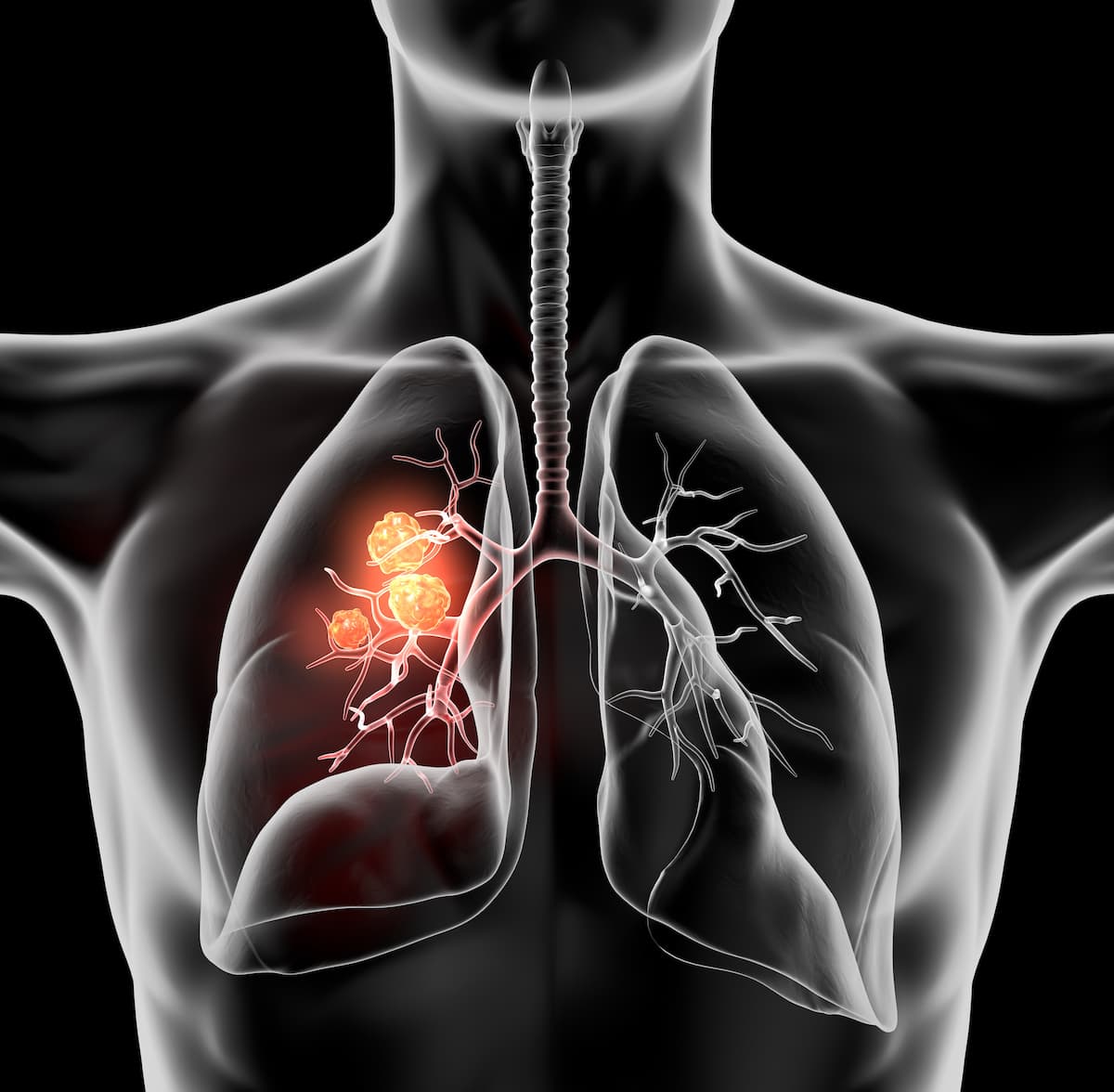Sintilimab/Chemo Improves Survival VS Chemo Alone in EGFR-Mutated NSCLC
Findings from the phase 3 ORIENT-31 trial support the use of sintilimab plus chemotherapy as a potential novel treatment strategy for those with EGFR-mutated nonsquamous non–small cell lung cancer.
Treatment with sintilimab in combination with chemotherapy yielded significant and clinically meaningful improvement in progression-free survival (PFS) compared with chemotherapy alone, and sintilimab plus bevacizumab (Avastin) biosimilar IBI305 and chemotherapy continued to demonstrate PFS benefits in patients with nonsquamous non–small cell lung cancer (NSCLC), according to findings from the phase 3 ORIENT-31 trial (NCT03802240)1.
"ORIENT-31 is globally the first prospective, randomized, double-blind phase 3 study that demonstrated significant PFS benefit of combination therapy of anti–PD-1 antibody and chemotherapy with or without bevacizumab in patients with EGFR-mutated nonsquamous NSCLC that progressed on prior EGFR-TKI therapy, which was revolutionary in immunotherapy," according to an expert from Shanghai Chest Hospital.

The median PFS was 5.5 months (95% CI, 4.5-6.1) in the sintilimab plus chemotherapy group vs 4.3 months (95% CI, 4.1-5.3) in the chemotherapy alone group (Hazard ratio [HR], 0.72; 95% CI, 0.55-0.94; P = .016). The estimated 6-month and 12-month PFS rates were 42.0% (95% CI, 33.5%-50.3%) vs 31.7% (95% CI, 24.1%-39.5%) and 20.5% (95% CI, 13.7%-28.3%) vs 11.4% (95% CI, 6.5%-17.7%) in each respective group.
Sintilimab plus chemotherapy produced a favorable HR for PFS compared with chemotherapy alone across most subgroups except for those who had Thr790Met mutations, those with exon 19 deletions, and those who received 2 prior lines of EGFR tyrosine kinase inhibitor (TKI) therapy.
Findings from the second interim analysis for patients receiving sintilimab plus IBI305 and chemotherapy indicated that the median PFS in this group was 7.2 months (95% CI, 6.6-9.3). Patients in this treatment group experienced sustained PFS benefits compared with those receiving chemotherapy alone (HR, 0.51; 95% CI, 0.39-0.67; P <.0001).
“ORIENT-31 is globally the first prospective, randomized, double-blind phase 3 study that demonstrated significant PFS benefit of combination therapy of anti–PD-1 antibody and chemotherapy with or without bevacizumab in patients with EGFR-mutated nonsquamous NSCLC that progressed on prior EGFR-TKI therapy, which was revolutionary in immunotherapy,” lead investigator Shun Lu, MD, PhD, a professor in the Oncology Department at Shanghai Chest Hospital, said in a press release on the trial.2
Investigators of the double-blind, placebo-controlled phase 3 ORIENT-31 trial administered treatment to patients across 52 centers in China. Patients were randomly assigned 1:1:1 to receive 200 mg of sintilimab plus 15 mg/kg of IBI305, 500 mg/m2 of pemetrexed, and 75 mg/m2 of cisplatin; sintilimab plus chemotherapy; or chemotherapy alone on day 1 of each 3-week cycle for 5 cycles followed by maintenance with sintilimab, IBI305, and pemetrexed.
The primary end point was PFS in the intent-to-treat population. Secondary end points included overall survival (OS), objective response rate (ORR), disease control rate (DCR), time to response, and duration of response (DOR).
Patients 18 to 75 years old with stage IIIB, IIIC, or IV EGFR-mutated nonsquamous NSCLC were eligible for enrollment on the trial. Additional eligibility criteria included having disease progression following treatment with TKIs and at least 1 measurable lesion per RECIST v1.1 criteria.
Investigators randomly assigned a total of 476 patients to receive treatment, including 158 in the sintilimab plus IBI305 and chemotherapy group, 158 in sintilimab and chemotherapy group, and 160 in the chemotherapy alone group. Across the 3 treatment groups, most patients had an ECOG performance status of 1 (76% vs 86% vs 84%), stage IV disease (96% vs 97% vs 98%), and EGFR exon 19 deletions (51% vs 54% vs 55%). All patients were Chinese.
Per independent radiographic review committee (IRRC), there was a confirmed ORR of 35% (95% CI, 27%-43%) in the sintilimab plus chemotherapy group and 29% (95% CI, 22%-37%) in the chemotherapy alone group. Additionally, the DCR was 82% (95% CI, 75%-87%) and 76% (95% CI, 68%-82%) in each respective group. In each respective group, the median time to response was 1.4 months (interquartile range [IQR], 1.3-2.8) vs 1.5 months (IQR, 1.4-3.0), and the median DOR was 7.4 months (95% CI, 4.7%-12.0%) vs 5.7 months (95% CI, 4.1-7.1).
Responses were consistent between IRRC- and investigator-based assessments.
The median OS was 21.1 months (95% CI, 17.5-23.9; HR, 0.98; 95% CI, 0.72-1.34) in the sintilimab plus IBI305 and chemotherapy group, 20.5 months (95% CI, 15.8-25.3; HR, 0.97; 95% CI, 0.71-1.32) in the sintilimab plus chemotherapy group, and 19.2 months (95% CI, 15.8-22.4) in the chemotherapy alone group. After adjusting for crossover, the HR for sintilimab plus IBI305 and chemotherapy compared with chemotherapy alone ranged from 0.79 (95% CI, 0.57-1.09) to 0.84 (95% CI, 0.61-1.15). The HR for sintilimab plus chemotherapy compared with chemotherapy alone ranged from 0.78 (95% CI, 0.57-1.08) to 0.84 (95% CI, 0.61-1.16).
Grade 3 or higher treatment-related adverse effects (TRAEs) occurred in 56% of patients in the sintilimab plus IBI305 and chemotherapy group, 41% of those in the sintilimab plus chemotherapy group, and 49% of those in the chemotherapy alone group. The most common grade 3 or higher TRAEs in each of the respective treatment groups included decreased neutrophil count (20% vs 18% vs 19%), anemia (13% vs 8% vs 12%), and decreased white blood cell count (11% vs 9% vs 9%).
References
- Lu S, Wu L, Cheng Y, et al. Sintilimab plus chemotherapy for patients with EGFR- mutated non-squamous non-small-cell lung cancer with disease progression after EGFR tyrosine-kinase inhibitor therapy (ORIENT-31): second interim analysis from a double- blind, randomised, placebo-controlled, phase 3 trial. Lancet Respir Med. Published online May 5, 2023. doi:10.1016/ S2213-2600(23)00135-2
- Innovent updates the results from the ORIENT-31 study of sintilimab plus chemotherapy with or without bevacizumab in patients with EGFR-TKI failed EGFR-mutated non-squamous non-small cell lung cancer in the Lancet Respiratory Medicine. News release. Innovent Biologics, Inc. May 6, 2023. Accessed May 8, 2023. bit.ly/44CUxVp